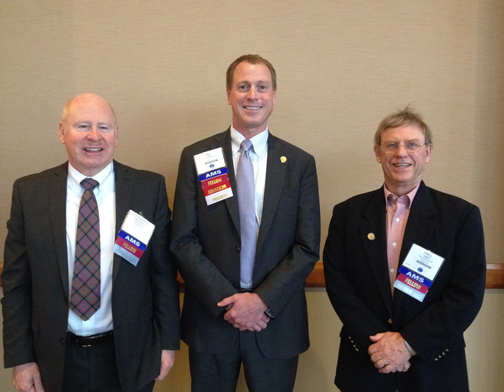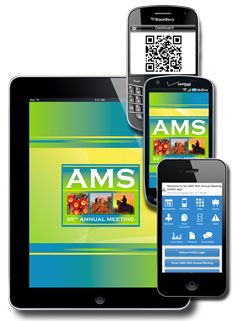Four episodes of The Weather Channel program “Weather Geeks” were taped in the Exhibit Hall yesterday, bringing large, enthusiastic crowds that made the Annual Meeting feel more like an ESPN College GameDay event. Some were even inspired to write haikus. Here’s a flavor of the action:
The Doctor is in! 15mins away… #AMS2015 pic.twitter.com/GWohS3lPCa
— WXGeeksTWC (@WXGeeksTWC) January 6, 2015
Its not quite College GameDay but handwritten signs made for the broadcast. I dont see any mascot heads either. #AMS2015
— Marcus Smith (@MRSmithSEWX) January 6, 2015
LOOK at the live crowd we have for @WXGeeksTWC! This is awesome. #AMS2015 pic.twitter.com/NDMWjzBkco
— Kathryn Prociv (@KathrynProciv) January 6, 2015
Watching @WXGeeksTWC taping at #AMS2015 with @kimklockow and @CommDocPA pic.twitter.com/NVMNwnpjlx
— Rick Smith (@ounwcm) January 6, 2015
@weatherchannel @wxgeekstwc haiku: Marshall Shepherd is the man. Giving the weather weenies voice on TV. It is amazing out there. #AMS2015
— Minh Phan (@WXMinh) January 6, 2015
@weatherchannel @WXGeeksTWC Send out the warning. Storms are on the horizon. The geeks are coming… #AMS2015 #WxHaiku
— Matthew Brown (@Rhapsodyinbrown) January 6, 2015
@hollylowry & I are so excited to be at a @WXGeeksTWC filming here at #AMS2015 ! Can't wait to watch in a few weeks! pic.twitter.com/KCFn9T0HTE
— Faith Eherts (@WxFaith) January 6, 2015
It's showtime! @WXGeeksTWC @DrShepherd2013 @CommDocPA #AMS2015 pic.twitter.com/oeKqyqqvht
— Amberrr (@Ambermometer) January 6, 2015
Geek scale turned up to 11 at the taping of WeatherGeeks. #AMS2015
— Chris Hattings (@wxgeekbeavis) January 6, 2015
.@KathrynProciv and I backstage for @WXGeeksTWC tapings at #AMS2015!! pic.twitter.com/YaIEuuNkbA
— Chrissy Warrilow (@AtlantaWxGirl) January 6, 2015
YES…THEY BROUGHT SIGNS RT @davidwkenny: #itsamazingotthere at #AMS2015 on @WXGeeksTWC @weatherchannel pic.twitter.com/ywh06JSBbr
— Sean Breslin (@Sean_Breslin) January 6, 2015
El presidente times two… Weather Geeks is taping now come check it out . #AMS2015 #wxgeeks pic.twitter.com/6nJywAYPw1
— Mike Chesterfield (@mchesterfield26) January 6, 2015
The people who made #AMS2015 @WXGeeksTWC possible and thank all of you for coming out. It's your show pic.twitter.com/jpuIW6nQGf
— Marshall Shepherd (@DrShepherd2013) January 7, 2015

